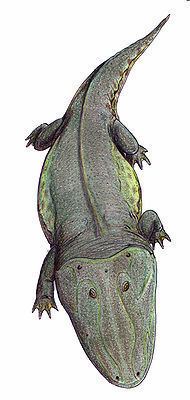Phylum Chordata | ||
 | ||
Clade †CapitosauriaSchoch and Milner, 2000 Similar | ||
An exceptionally well preserved skull of stanocephosaurus temnospondyli capitosauria
Capitosauria is an extinct group of large temnospondyl amphibians with simplified stereospondyl vertebrae. Mainly living as piscivores in lakes and rivers, the Capitosauria and its sister taxon Trematosauria were the only major labyrinthodonts that existed during the Mesozoic in ecological niches broadly similar to those of modern crocodiles, and some grew to very large sizes. At 6 meter in length, the Mid-Triassic Mastodonsaurus giganteus is not only thought to have been the largest capitosaur, but possibly also the largest amphibian to have lived. The capitosaurs enjoyed a brief period of success in the early Triassic, but with the rise of crocodiles in the middle Triassic they went into decline, and the capitosaur lineage is not known beyond the Late Triassic.
Contents
- An exceptionally well preserved skull of stanocephosaurus temnospondyli capitosauria
- Phylogeny
- References
Capitosauria was first named by Schoch and Milner (2000) and further described by Yates and Warren (2000), who assigned Lydekkerina and Mastodonsauroidea to it. It was described by Damiani (2001) under the name Mastodonsauroidea. In their phylogenetic analysis of temnospondyls, Ruta et al. (2007) placed Lydekkerina and its relatives within the clade Rhytidostea, while placing only mastodonsauroid taxa within Capitosauria.
Phylogeny
Below is a cladogram from Fortuny et al. (2011) showing the phylogenetic relationships of capitosaurs:
